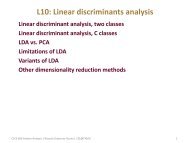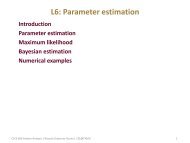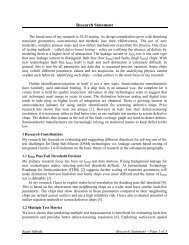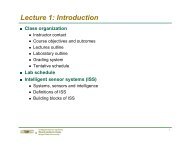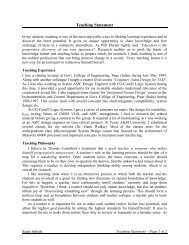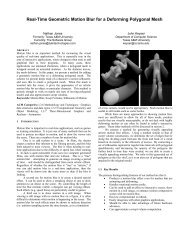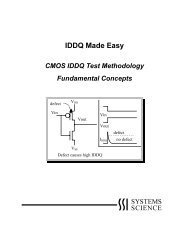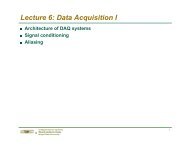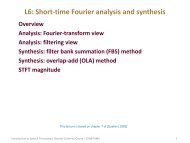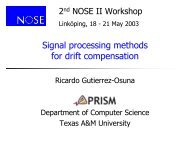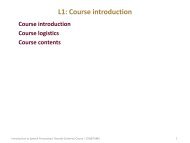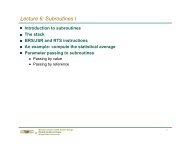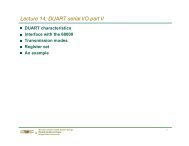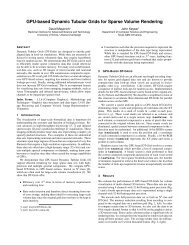presentation slides - Texas A&M University
presentation slides - Texas A&M University
presentation slides - Texas A&M University
You also want an ePaper? Increase the reach of your titles
YUMPU automatically turns print PDFs into web optimized ePapers that Google loves.
“Research is to see what everyone else has seen<br />
and think what no one else has thought.”<br />
Albert Einstein
Integrated Circuit<br />
Outlier Identification by<br />
Multiple Parameter Correlation<br />
Sagar Sabade<br />
Department of Computer Science<br />
<strong>Texas</strong> A&M <strong>University</strong>, MS 3112<br />
College Station, TX 77843-3112<br />
E-mail: sagar@tamu.edu
Outline<br />
Introduction<br />
Problem Definition<br />
Prior Work<br />
Research Goals<br />
Research Plan<br />
Summary
14 mm<br />
Test: Needle Search In Haystack<br />
Intel ® Pentium 4 chip layout<br />
© Intel Corporation<br />
14 mm<br />
Particle<br />
~130 nm<br />
130 nm technology<br />
Miles of copper interconnect<br />
42 million transistors
Smaller Needle, Bigger Haystack<br />
© IBM Corporation
Semiconductor Economics 101<br />
Cost – the prime drive for technology<br />
Manufacturing cost/transistor falls rapidly<br />
higher performance/cost ratio<br />
Complexity increasing with each technology<br />
advancement<br />
Test cost falls slowly<br />
Increasing test cost contribution to overall cost<br />
Tester time extremely valuable<br />
Important to find defective chip early in test cycle or<br />
manufacturing flow
Basic Testing Methodology<br />
Input<br />
1<br />
0<br />
1<br />
1<br />
0<br />
1<br />
0<br />
1<br />
Apply inputs to<br />
excite the defect<br />
1<br />
0<br />
defect<br />
(Fault-free)<br />
Output<br />
1<br />
1<br />
1<br />
0<br />
1<br />
0<br />
1<br />
0<br />
and propagate its<br />
effect to the output<br />
(Faulty)<br />
Output<br />
1<br />
0<br />
1<br />
0<br />
1<br />
0<br />
0<br />
0<br />
Defect detected<br />
only if output<br />
different from<br />
fault-free output
So Many Defects, So Little Time<br />
Billions of possible defects<br />
Fortunately have similar effect on electrical<br />
characteristics<br />
Modeled using higher level of abstraction called<br />
“fault”<br />
Defect physical (e.g. short between lines)<br />
Fault electrical (e.g. increased current)<br />
Many (possible) defects map to the same fault
IC Testing Methods<br />
Functional testing (Black box)<br />
Verify “correctness” of chip, conformance to<br />
specifications<br />
Exponential test time<br />
Structural testing (White box)<br />
Verify “integrity” of chip structure<br />
Too abstract, no implicit confidence about function<br />
Defect-based testing<br />
Verify absence of defect<br />
If no defects detected, chip should be fault-free<br />
Test methods complementary in nature
Defect-based Test Types<br />
Boolean test<br />
Can distinguish between faulty or fault-free<br />
chips<br />
Continuous parameter test<br />
No clear faulty/fault-free distinction<br />
Leakage current (I DDQ ) test
Leakage Current (I DDQ) Test<br />
Primary measurement leakage current<br />
Current drawn from the supply when the<br />
inputs are stable<br />
Can be measured at power supply (V DD ) line<br />
or at the ground (called I SSQ )
Basics of I DDQ Testing<br />
Premise: Fault-free CMOS chips have low<br />
leakage<br />
V DD<br />
Defect<br />
Input Output<br />
I DD<br />
Input<br />
Output<br />
I DD<br />
Low fault-free I DDQ<br />
High defective I DDQ<br />
Time
Defect Types<br />
Active (pattern-dependent) defect<br />
Leakage current high for some but not all<br />
patterns<br />
e.g. gate-to-source short, gate oxide short<br />
Passive (pattern-independent) defect<br />
High leakage current for all input patterns<br />
e.g. V DD -GND short
Advantages of I DDQ Testing<br />
Simple, intuitive<br />
No propagation requirements<br />
100% observability<br />
Fortuitous detection<br />
Fewer vectors needed for higher fault detection<br />
capability<br />
Detects several defect types<br />
GOS, stuck-on, punch-through, bridges<br />
Detects some latent defects<br />
Useful for screening low-reliability chips
Conventional I DDQ Testing<br />
Single threshold method<br />
Threshold decided using circuit simulations or<br />
empirically<br />
I DDQ<br />
Rejected chips<br />
Accepted chips<br />
Chip<br />
Threshold
Technology Impact on I DDQ Test<br />
Reduced transistor geometries<br />
Increases leakage current exponentially<br />
Increased process variations<br />
Cannot distinguish between faulty and fault-free<br />
leakage currents using a single threshold<br />
Small threshold rejects too many good chips<br />
Yield loss (lost revenue)<br />
High threshold accepts too many flawed chips<br />
Test escapes (customer returns)
ITRS Projections for I DDQ<br />
Year Gate Length (nm) I DDQ<br />
2001 90 30 – 70 mA<br />
2003 65 70 – 150 mA<br />
2005 45 150 – 400 mA<br />
2008 35 400 mA – 1.6A<br />
2011 25 1.6 – 8 A<br />
2014 15 8 – 20 A<br />
For high-performance microprocessor circuits<br />
Source: Intl. Technology Roadmap for Semiconductors (ITRS) 2001
I DDQ Test in Deep Sub-Micron<br />
Earlier Technologies<br />
Threshold<br />
Fault-free Faulty<br />
I DDQ<br />
Deep Sub-Micron Technologies<br />
Test Escapes<br />
Threshold<br />
Fault-free Faulty<br />
I DDQ<br />
Yield Loss
I DDQ and Defect Severity<br />
Frequency<br />
100<br />
10<br />
1<br />
Fault-free<br />
Subtle defect<br />
0.1 1 10 100 1000<br />
ID DQ (uA)<br />
Fatally flawed<br />
Gross defect
I DDQ Too Important to Lose<br />
Important component of test suite<br />
Capable of detecting some unique defects<br />
When used with other test methods, it can reduce test<br />
escapes/defect level<br />
Detects some latent defects<br />
Useful for screening low reliability chips<br />
Useful as an alternative to burn-in (BI)<br />
BI less effective and expensive for DSM technologies<br />
Reduced voltage and temperature acceleration
I DDQ Only a Part of the Puzzle<br />
Increased<br />
Leakage<br />
Increased<br />
Test cost<br />
Inaccurate<br />
Fault models<br />
&<br />
New<br />
Defect<br />
Mechanisms<br />
Process<br />
Variability<br />
Test time/data<br />
Reduction &<br />
Insufficient<br />
Fault coverage<br />
Reliability<br />
Screens losing<br />
effectiveness
Research Focus<br />
This research focuses on using statistical outlier<br />
rejection methods for identifying flawed chips<br />
that might lead to functional failure.<br />
outlier
Why Use Outlier Detection?<br />
Continuous parameter spectrum<br />
Must distinguish flawed chips from “fatally”<br />
flawed ones<br />
Flawed chips show different behavior than<br />
others<br />
Appear as an “outliers”<br />
Outlier detection useful for differentiation
What is an Outlier?<br />
Outlier<br />
A chip that exhibits markedly different<br />
parameter(s) or variation in parameter(s)<br />
compared to other chips<br />
Improving confidence in differentiating<br />
“true” outliers is the motivation for this<br />
research
Outlier Identification Methods<br />
Reliance on properties of standard<br />
distributions<br />
Mean, standard deviation, median, range<br />
Various methods<br />
Z-scores test<br />
Chauvenet’s criterion<br />
Tukey method<br />
Median of Absolute Deviations (MAD) test
Why is Outlier Detection Difficult?<br />
Outliers affect properties of the distribution<br />
Several orders of magnitude variation in<br />
fault-free I DDQ itself<br />
Makes difficult to distinguish between a “true”<br />
outlier and an “apparent” outlier<br />
Outliers chips are functionally okay<br />
Manufacturer’s dilemma (yield loss vs.<br />
quality)
Frequency<br />
No Silver Bullet<br />
180<br />
160<br />
140<br />
120<br />
100<br />
80<br />
60<br />
40<br />
20<br />
0<br />
Frequency<br />
180<br />
160<br />
140<br />
120<br />
100<br />
80<br />
60<br />
40<br />
Frequency<br />
180<br />
160<br />
140<br />
120<br />
100<br />
80<br />
60<br />
N = 176<br />
Mean 2.5 µA<br />
STD 8.3<br />
20<br />
0<br />
0 500 1000 1500<br />
40<br />
20<br />
2000 2500<br />
0<br />
0 2<br />
N = 151<br />
4<br />
Mean 0.44 µA<br />
IDDQ (µA)<br />
STD 0.18<br />
6 8<br />
IDDQ (µA)<br />
0<br />
0 20 40 60<br />
N = 197<br />
Mean 678 µA<br />
STD 2142.65<br />
N = 179<br />
Mean 19.58 µA<br />
STD 176.35<br />
outliers<br />
0 2000 4000 6000 8000<br />
IDDQ (µA)<br />
Frequency<br />
20<br />
10<br />
8<br />
6<br />
4<br />
2<br />
IDDQ (µA)<br />
Frequency<br />
Wafer level data for a vector<br />
10<br />
N = 166<br />
Mean 0.84 µA<br />
STD 1.43<br />
0<br />
0.0 0.2 0.4 0.6 0.8 1.0 1.2 1.4<br />
IDDQ (µA)
Suggested Solution Methods<br />
Approach 1<br />
Reduce fault-free I DDQ<br />
Makes identifying faulty I DDQ easier<br />
Approach 2<br />
Estimate fault-free I DDQ accurately<br />
Approach 3<br />
Reduce variation in fault-free I DDQ data<br />
Makes faulty I DDQ “stand out”<br />
Category known as I DDX
Approach 1:<br />
Reducing Fault-free I DDQ<br />
Reduce temperature<br />
Too expensive, slow, impractical<br />
Less effective for future technologies<br />
Reverse (back) body bias<br />
Technology change, inflexible<br />
Less effective due to limited backbias voltage<br />
Silicon-On-Insulator (SOI)<br />
Different technology, learning curve<br />
Multiple-threshold transistors<br />
Performance tradeoff, less effective in future
Approach 2:<br />
Estimating Fault-free I DDQ<br />
Model-based estimation<br />
Usually switch-level (transistor) modeling<br />
Mostly design-specific<br />
Time consuming for large chips<br />
Does not address process variation issue<br />
very well<br />
Empirical estimation of fault-free I DDQ<br />
Requires extensive analysis of data
Die 1 I DDQ Variation<br />
Level 2<br />
Level 1
Die 2 I DDQ Variation<br />
Small spread
Die 1 and Die 2 I DDQ Variation<br />
Die 1 readings<br />
Die 1<br />
Die 2
Die 1, 2 and 3 I DDQ Variation<br />
Die 3<br />
Die 3 levels<br />
Die 2<br />
Die 1<br />
Is Die 1 really<br />
Defective?
Four Dice From a Wafer<br />
Difficult to determine which of these dice are<br />
Defective and which ones are fault-free.
Approach 3:<br />
I DDX Test Methods<br />
Current Signature<br />
Delta-I DDQ<br />
Histogram-based Method<br />
Correlation with other parameters<br />
Wafer XY location<br />
Frequency (F max)<br />
Flush delay
Current Signature [Gattiker,Maly]<br />
Signature – sorted I DDQ measurements<br />
A chip with active defect shows a “step” or<br />
“jump” in the signature<br />
Indicates multiple paths current can take<br />
Fault-free chip shows smooth signature<br />
Also true for passive defects<br />
Cannot screen passive and subtle active<br />
defects
Current Signatures Example<br />
Passive<br />
Defect?<br />
Active<br />
Defect<br />
Faulty/<br />
Fault-free?<br />
Fault-free
Differential/Delta I DDQ [Thibeault]<br />
Differences (deltas) in consecutive<br />
readings small for a fault-free chip<br />
Background leakage gets cancelled<br />
Cannot screen passive defects<br />
Less effectiveness in future [Krusemann]
Histogram-based Analysis<br />
Frequency<br />
Reduce σ,<br />
Mean ~ 0<br />
0<br />
Delta-I DDQ<br />
I DDQ values<br />
I DDQ
Current Ratios [Maxwell et al.]<br />
CR relatively constant for fault-free chips<br />
CR = Max I DDQ<br />
Min I DDQ<br />
Measure I DDQ for the “minimum I DDQ<br />
vector”<br />
Set limits on all other vectors dynamically<br />
Min. I DDQ vector changes from chip to chip
Current Ratios Example<br />
Courtesy: Peter Maxwell, Agilent Technologies
Threshold Selection Challenge<br />
Max I DDQ / Min I DDQ<br />
1000<br />
100<br />
10<br />
1<br />
I DDQ > 5 µA<br />
I DDQ < 5 µA<br />
1 10 100 1000 10000<br />
Chip number<br />
Which is the<br />
“correct”<br />
threshold?
Outlier Identification by Correlation<br />
Correlation useful for estimating fault-free I DDQ<br />
Can be used for outlier identification<br />
Different methods<br />
Vector-to-vector correlation [Unni et al.]<br />
Die-to-die correlation<br />
Die XY position on wafer [Daasch et al.]<br />
Other parameters<br />
F max [Keshavarzi et al.]<br />
Flush delay [Sabade et al.]
Motivation: Spatial Correlation<br />
Similar process conditions for neighboring<br />
chips on a wafer<br />
Fault-free chip parameters are expected to<br />
be similar<br />
A sudden change in any parameter is<br />
indicative of anomalous behavior<br />
Likely defective [Singh et al.]<br />
Called “spatial outliers”
Spatial Outlier Example<br />
IDDQ (µA)<br />
50<br />
40<br />
30<br />
20<br />
10<br />
0<br />
2<br />
4<br />
6<br />
8<br />
X Coordinate<br />
10<br />
12<br />
Spatial outliers<br />
14<br />
16<br />
2<br />
101214161820<br />
8<br />
6<br />
4<br />
Y Coodinate
Local Neighborhood Definition<br />
Center die
Estimation of Fault-free I DDQ<br />
Use neighboring chips’ I DDQ for estimating<br />
fault-free I DDQ of the center die<br />
If actual I DDQ is higher, center die is likely to<br />
be defective<br />
If actual I DDQ is lower, neighbor die could be<br />
defective<br />
How high is high? How low is low?<br />
Threshold setting does not disappear
Correlation Methods<br />
Spatial/plane fit<br />
Neighbor Current Ratios (NCR)<br />
Immediate Neighbor Difference I DDQ Test<br />
(INDIT)<br />
Correlation with flush delay
Plane Fit<br />
I DDQ function of neighboring dice I DDQ and<br />
die’s XY position on wafer<br />
First reject gross outliers<br />
Linear regression<br />
Z (I DDQ) = A .x + B .y + C<br />
I DDQ<br />
Best fit plane<br />
X<br />
Y<br />
wafer
Neighbor Current Ratios (NCR)<br />
Two neighboring chips should have similar<br />
I DDQ for identical vectors i<br />
NCR (i) =<br />
I DDQ die 1 (i)<br />
I DDQ die 2 (i)<br />
~ 1<br />
Process variations cause NCRs to vary<br />
Mean value close to 1<br />
High NCR indicates defective die (Die 1)
NCR Illustration<br />
Max NCR<br />
1200<br />
1000<br />
800<br />
600<br />
400<br />
200<br />
0<br />
2<br />
4<br />
6<br />
X<br />
8<br />
10<br />
12<br />
14<br />
16<br />
2<br />
101214161820<br />
8<br />
6<br />
4<br />
Y<br />
Obvious spatial outliers
Max NCR<br />
Max NCR<br />
CR/NCR Insights<br />
100<br />
10<br />
1<br />
0.1<br />
0.01<br />
0.001<br />
0.0001<br />
0.00001<br />
100<br />
10<br />
1<br />
0.1<br />
0.01<br />
0.001<br />
All pass – All pass<br />
1 10 100<br />
CR<br />
1 10 100<br />
CR<br />
All pass – Any fail<br />
Max NCR<br />
Max NCR<br />
1000<br />
100<br />
10<br />
1<br />
0.1<br />
0.01<br />
0.001<br />
0.0001<br />
1000<br />
100<br />
10<br />
1<br />
IDDQ fail – IDDQ fail<br />
1 10 100 1000 10000<br />
CR<br />
1 10 100 1000<br />
CR<br />
IDDQ fail – Boolean fail
Healer Chips and CR/NCR<br />
Healer – a chip that shows elevated I DDQ<br />
before BI and reduced I DDQ after BI<br />
Need more careful analysis<br />
Max NCR<br />
1000<br />
100<br />
10<br />
1<br />
0.1<br />
0.01<br />
0.001<br />
1 10 100 1000<br />
CR
Immediate Neighbor Difference<br />
I DDQ Test (INDIT)<br />
Ratios may pass some outliers<br />
IND (i) = IDDQ Die 1 (i) – IDDQ Die 2 (i) ~ 0<br />
Differences in I DDQ for same vectors ~ 0<br />
Process variations cause variation
Why Multi-parameter Test?<br />
I DDQ test alone not enough<br />
Pass/fail decision difficult and prone to error<br />
Can result in yield loss/test escapes<br />
Need higher confidence in detecting flawed<br />
chips<br />
Defect detection capability diminishing for each<br />
test method in isolation<br />
Defect detection harder with each technology node
I DDQ & Flush Delay Correlation<br />
Flush delay (ns)<br />
500<br />
480<br />
460<br />
440<br />
420<br />
400<br />
380<br />
360<br />
340<br />
0.01 0.1 1 10 100<br />
Minimimum IDDQ (uA)<br />
Flush delay (ns)<br />
490<br />
470<br />
450<br />
430<br />
410<br />
390<br />
370<br />
350<br />
0 0.2 0.4 0.6 0.8 1<br />
Min IDDQ (uA)
Research Goals<br />
Identify outlier chips<br />
Distinguish between real and seemingly<br />
outliers<br />
Exploit wafer-level spatial dependence<br />
Correlate multiple test measurements<br />
Vector-to-vector for the same chip<br />
Across multiple chips, wafers or lots<br />
Evaluate possibility for burn-in reduction
Research Plan - I<br />
Extensive analysis of SEMATECH data<br />
Evaluate different ideas<br />
Correlate with BI results to validate methods<br />
Data rather outdated (0.6 micron)<br />
Recent data obtained from LSI Logic<br />
No BI data available<br />
How to validate methods?<br />
Proposal sent to <strong>Texas</strong> Instruments<br />
Discussed with Philips, IBM, Sony
Research Plan - II<br />
Use advanced statistical methods<br />
Factor analysis<br />
Understand underlying process variations, compare<br />
estimated I DDQ with model<br />
Evaluate different outlier identification methods<br />
Chauvenet’s criterion, Tukey method, Median of<br />
Absolute Deviations (MAD), etc.<br />
Evaluate use of mean vs. median<br />
Estimate yield loss/defect level improvements
Research Contributions<br />
Systematic identification of outlier chips<br />
Neighboring chips’ parameter-based<br />
estimation and statistical analysis for<br />
defective chip screening<br />
Insight into underlying process variations<br />
Possible burn-in reduction or elimination<br />
Test cost reduction
Research Benefits<br />
Early detection of<br />
defective chips<br />
or latent defects<br />
Burn-in reduction<br />
Or<br />
Elimination<br />
Increased Profit<br />
Understanding process<br />
glitches, variations<br />
& yield excursions<br />
Test cost reduction,<br />
Reduced DPM<br />
Reduced customer returns
Summary<br />
Defect-based VLSI testing faces difficult<br />
challenges; I DDQ test loses its effectiveness<br />
Single parameter testing loses its effectiveness<br />
in screening faulty chips<br />
Correlating multiple test measurements<br />
necessary to screen true outliers<br />
Wafer-level test can be useful in reducing test<br />
time and overall test cost<br />
Has potential to reduce burn-in
Questions?
Backup Slides
Pattern Dependent Defect<br />
Input Output IDDQ<br />
1 0 low<br />
I/P O/P<br />
0 1 high Defect Detected!<br />
Gate to source short
I/P<br />
Pattern Independent Defect<br />
O/P<br />
Input Output IDDQ<br />
1 0 high<br />
0 1 high<br />
Resistive bridge
Short Channel Effect<br />
Gate begins to lose<br />
Control over the channel<br />
Effective V th reduced<br />
(V t Roll-off)<br />
V th<br />
Gate Length (um)
Process Variation Levels<br />
Frequency<br />
Parameter Value<br />
Lot to lot<br />
Wafer to wafer<br />
Inter die (same wafer)<br />
Intra-die (vector)
VLSI Technology Advancement<br />
Reduced transistor geometries<br />
Higher transistor counts<br />
Higher levels of integration (SoC designs)<br />
Increasing device complexity (9 metal layers)<br />
Mixed signal design (more analog)<br />
New materials (low-K, high-K)<br />
Lower supply and threshold voltages<br />
Higher leakage currents and power dissipation
Technology Impact on Testing<br />
Reduced transistor geometries<br />
Increased process variations<br />
New defect mechanisms<br />
Inaccurate fault models<br />
Higher levels of integration<br />
Reduced observability and controllability of defects<br />
Higher leakage currents<br />
Unable to distinguish faulty currents<br />
Reduced voltage, increased temperature<br />
Reduced effectiveness of reliability screens
Impact on I DDQ Testing<br />
Reduced transistor geometries<br />
Reduced supply voltages to avoid gate oxide<br />
breakdown<br />
Necessary to reduce threshold voltage for<br />
performance requirements<br />
Increases leakage current exponentially<br />
Cannot distinguish between faulty and fault-free<br />
leakage currents using a single threshold<br />
Unacceptable yield loss and/or test escapes<br />
Large process variations make it worse!
Scaling Implications on IOFF<br />
I OFF<br />
(nA/um)<br />
ITRS Projections for High-performance Microprocessors<br />
Target Supply Voltage (V DD )
CMOS Scaling Fundamentals<br />
Scaling to 1/K reduces the drain current<br />
Propagation delay is reduced to 1/K.
Non-uniform Scaling Trends<br />
Source : ITRS 2001<br />
T ox scales faster than<br />
V DD<br />
Increased electrical<br />
field<br />
Performance depends<br />
on V DD -V t<br />
V t scales slower than<br />
V DD due to Boltzmann<br />
statistics
I DDQ Variation (All Chips)<br />
Max I DDQ (µA)<br />
10000<br />
1000<br />
100<br />
10<br />
1<br />
0.1<br />
0.01<br />
0.01<br />
0.1<br />
1<br />
Min I DDQ (µA)<br />
10<br />
100<br />
“All pass” chips<br />
1000<br />
10000<br />
0.01<br />
0.1<br />
1<br />
10<br />
10000<br />
1000<br />
100<br />
Med I DDQ ( µA)
“All Pass” Chips I DDQ Variation<br />
Max I DDQ (µA)<br />
5<br />
4<br />
3<br />
2<br />
1<br />
0.01<br />
0.1<br />
Min I DDQ (µA)<br />
1<br />
1<br />
2<br />
3<br />
4<br />
Med I DDQ (µA)<br />
5<br />
Several outliers<br />
Are all defective?
Actual I DDQ Distribution<br />
Optimum Threshold?
Leakage Current Components<br />
Input = 1<br />
Output = 0<br />
P + P +<br />
n + n +<br />
I G<br />
I DW<br />
Reverse biased PN junction leakage<br />
Subthreshold current (weak inversion)<br />
Gate Induced Drain Leakage (GIDL)<br />
Drain Induced Barrier Lowering (DIBL)<br />
Punch-through Leakage<br />
Tunneling leakage through gate oxide<br />
I D<br />
IDS IDIBL IPT IGIDL P +<br />
n +<br />
V DD<br />
P + N-well<br />
substrate
Leakage Current Components<br />
Input = 0<br />
Output = 1<br />
P + P +<br />
n + n +<br />
IDS<br />
I DW<br />
Reverse biased PN-junction leakage<br />
Subthreshold leakage<br />
ID<br />
Punch-through leakage<br />
Gate Induced Drain Leakage (GIDL)<br />
IG<br />
P +<br />
Drain Induced Barrier Lowering (DIBL)<br />
n +<br />
V DD<br />
P + N-well<br />
substrate<br />
Tunneling leakage
Major I DDQ Components<br />
I D<br />
(Log scale)<br />
GIDL<br />
Weak inversion<br />
& Junction leakage<br />
0 V G<br />
DIBL<br />
VD = 4.0 V<br />
VD = 2.7 V<br />
V D = 0.1 V
Do We Need a Smart Tester?<br />
“Automatic Test Equipment (ATE) is a<br />
misnomer. It should be called Automatic<br />
Measuring Equipment (AME). …We need<br />
statistical methods to discriminate faulty<br />
chips [from fault-free ones].”<br />
- Robert Madge (LSI Logic) at Industrial Test<br />
Challenges talk at Intel in May 2002
Two Signature Types<br />
IDDQ (uA)<br />
54.5<br />
54.0<br />
53.5<br />
53.0<br />
52.5<br />
52.0<br />
51.5<br />
51.0<br />
50.5<br />
0 50 100 150 200<br />
Number<br />
Pattern Dependent<br />
Current Signature<br />
IDDQ (uA)<br />
15<br />
14<br />
13<br />
12<br />
11<br />
10<br />
9<br />
8<br />
7<br />
6<br />
5<br />
4<br />
3<br />
2<br />
1<br />
0<br />
0 50 100 150 200<br />
Number<br />
Pattern Independent<br />
Current Signature<br />
(Background leakage)
Radial I DDQ Variation<br />
IDDQ (uA)<br />
10<br />
1<br />
0.1<br />
I DDQ for a single vector shown<br />
0 2 4 6 8 10 12<br />
Radial distance (cm)
Handling Defect Clustering<br />
Scratch<br />
226 defects,<br />
Mechanical handling<br />
Defects detected with<br />
Optical in-line tools<br />
Particle contamination<br />
617 defects,<br />
CVD process contamination<br />
Source: Semiconductor Spatial Signature Analysis (SSA)
Correlation: What Does It Mean?<br />
B<br />
A<br />
Positive correlation<br />
B<br />
A<br />
Negative correlation<br />
B<br />
A<br />
No correlation
Why I DDQ Correlates to Delay?<br />
Smaller L eff faster transistor<br />
Smaller L eff more leakage<br />
P<br />
N+ N+<br />
L eff
How Reverse Body Bias Works?<br />
Reverse potential applied to substrate<br />
increases effective V th<br />
This reduces leakage current<br />
Penalty switching speed reduces
All Tests Are Needed<br />
Distribution of package test results for SEMATECH data<br />
5 uA IDDQ Test<br />
Stuck-at Test<br />
P – Pass, F – Fail<br />
P<br />
P<br />
F<br />
F<br />
P P<br />
F F<br />
6 1463 7<br />
14 0 34 1<br />
6 1 13 8<br />
52 36 1251<br />
P F P F<br />
Functional Test<br />
P<br />
F<br />
P<br />
F<br />
Delay Test
Is I DDQ Irreplaceable?<br />
Wafer Test<br />
At-speed<br />
IDDQ Functional IDDQ<br />
2467<br />
343<br />
73<br />
1545<br />
65<br />
3118<br />
35<br />
46<br />
42<br />
34<br />
121<br />
Stuck-at 23<br />
Scan<br />
+ 56 fail only IDDQ + AC scan<br />
+ 4 only functional + stuck-at<br />
98<br />
AC scan<br />
Stuck-at<br />
Scan<br />
521 48 19<br />
12<br />
6<br />
Package Test<br />
31<br />
46<br />
6<br />
25 25<br />
AC scan<br />
+ 36 fail only IDDQ + AC scan<br />
8<br />
7<br />
At-speed<br />
Functional<br />
150000 die at wafer, 76000 dice after package, package values normalized to wafer good parts<br />
Source: Peter Maxwell, Talk at Industrial Test Challenges, May 2002.<br />
4
Fewer Vectors,Higher Coverage<br />
Fault<br />
Coverage %<br />
100<br />
90<br />
80<br />
70<br />
60<br />
50<br />
40<br />
30<br />
20<br />
10<br />
FC by<br />
I DDQ tests<br />
For same FC I DDQ tests require<br />
many fewer vectors than functional test<br />
FC by<br />
functional tests<br />
Vector Number
Optimum Threshold Selection<br />
Frequency<br />
Cost vs. Quality debate<br />
Zero Test Escapes<br />
High<br />
Overkill<br />
Optimum Threshold<br />
I DDQ<br />
Fault-free chips<br />
Faulty chips<br />
Zero Yield Loss<br />
High<br />
Defect Level
Wafer-level Analysis: Advantages<br />
Detection of defective chips at wafer probe<br />
Reduction in test costs and time<br />
Reduced packaging cost/die<br />
Provides insight into understanding underlying<br />
process variations<br />
Useful for detecting process glitches<br />
Different pass/fail criterion for different wafers<br />
Reduce yield penalty for fast and leaky wafers
Values on Logarithmic Scale
Delta I DDQ Illustration<br />
First measurement<br />
I DDQ<br />
Defective<br />
Defective<br />
Vector number<br />
Guard band
Defect Detection<br />
Source: icknowledge.com
Technology Trends
I DDQ Test for Deep Sub-Micron<br />
Yield loss and test escapes inevitable<br />
Frequency<br />
Fault-free<br />
chips<br />
I DDQ<br />
Ith<br />
Faulty chips<br />
Earlier Technologies<br />
Frequency<br />
Fault-free<br />
chips<br />
I th<br />
I DDQ<br />
Faulty chips<br />
Test Escapes Yield Loss<br />
DSM Technologies



